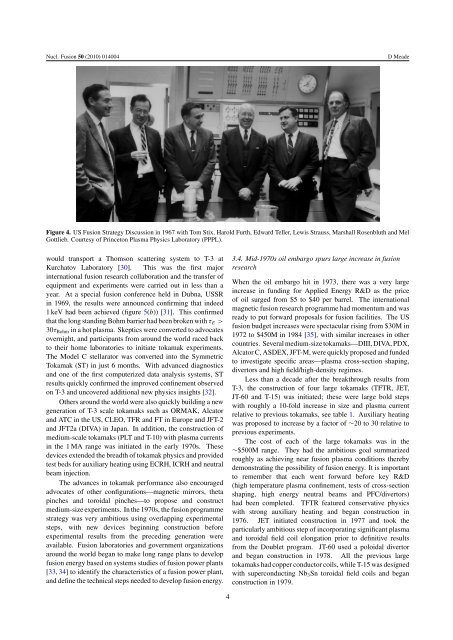50 years of fusion research - Princeton Plasma Physics Laboratory
50 years of fusion research - Princeton Plasma Physics Laboratory
50 years of fusion research - Princeton Plasma Physics Laboratory
Create successful ePaper yourself
Turn your PDF publications into a flip-book with our unique Google optimized e-Paper software.
Nucl. Fusion <strong>50</strong> (2010) 014004 D Meade<br />
Figure 4. US Fusion Strategy Discussion in 1967 with Tom Stix, Harold Furth, Edward Teller, Lewis Strauss, Marshall Rosenbluth and Mel<br />
Gottlieb. Courtesy <strong>of</strong> <strong>Princeton</strong> <strong>Plasma</strong> <strong>Physics</strong> <strong>Laboratory</strong> (PPPL).<br />
would transport a Thomson scattering system to T-3 at<br />
Kurchatov <strong>Laboratory</strong> [30]. This was the first major<br />
international <strong>fusion</strong> <strong>research</strong> collaboration and the transfer <strong>of</strong><br />
equipment and experiments were carried out in less than a<br />
year. At a special <strong>fusion</strong> conference held in Dubna, USSR<br />
in 1969, the results were announced confirming that indeed<br />
1 keV had been achieved (figure 5(b)) [31]. This confirmed<br />
that the long standing Bohm barrier had been broken with τE ><br />
30τBohm in a hot plasma. Skeptics were converted to advocates<br />
overnight, and participants from around the world raced back<br />
to their home laboratories to initiate tokamak experiments.<br />
The Model C stellarator was converted into the Symmetric<br />
Tokamak (ST) in just 6 months. With advanced diagnostics<br />
and one <strong>of</strong> the first computerized data analysis systems, ST<br />
results quickly confirmed the improved confinement observed<br />
on T-3 and uncovered additional new physics insights [32].<br />
Others around the world were also quickly building a new<br />
generation <strong>of</strong> T-3 scale tokamaks such as ORMAK, Alcator<br />
and ATC in the US, CLEO, TFR and FT in Europe and JFT-2<br />
and JFT2a (DIVA) in Japan. In addition, the construction <strong>of</strong><br />
medium-scale tokamaks (PLT and T-10) with plasma currents<br />
in the 1 MA range was initiated in the early 1970s. These<br />
devices extended the breadth <strong>of</strong> tokamak physics and provided<br />
test beds for auxiliary heating using ECRH, ICRH and neutral<br />
beam injection.<br />
The advances in tokamak performance also encouraged<br />
advocates <strong>of</strong> other configurations—magnetic mirrors, theta<br />
pinches and toroidal pinches—to propose and construct<br />
medium-size experiments. In the 1970s, the <strong>fusion</strong> programme<br />
strategy was very ambitious using overlapping experimental<br />
steps, with new devices beginning construction before<br />
experimental results from the preceding generation were<br />
available. Fusion laboratories and government organizations<br />
around the world began to make long range plans to develop<br />
<strong>fusion</strong> energy based on systems studies <strong>of</strong> <strong>fusion</strong> power plants<br />
[33, 34] to identify the characteristics <strong>of</strong> a <strong>fusion</strong> power plant,<br />
and define the technical steps needed to develop <strong>fusion</strong> energy.<br />
4<br />
3.4. Mid-1970s oil embargo spurs large increase in <strong>fusion</strong><br />
<strong>research</strong><br />
When the oil embargo hit in 1973, there was a very large<br />
increase in funding for Applied Energy R&D as the price<br />
<strong>of</strong> oil surged from $5 to $40 per barrel. The international<br />
magnetic <strong>fusion</strong> <strong>research</strong> programme had momentum and was<br />
ready to put forward proposals for <strong>fusion</strong> facilities. The US<br />
<strong>fusion</strong> budget increases were spectacular rising from $30M in<br />
1972 to $4<strong>50</strong>M in 1984 [35], with similar increases in other<br />
countries. Several medium-size tokamaks—DIII, DIVA, PDX,<br />
Alcator C, ASDEX, JFT-M, were quickly proposed and funded<br />
to investigate specific areas—plasma cross-section shaping,<br />
divertors and high field/high-density regimes.<br />
Less than a decade after the breakthrough results from<br />
T-3, the construction <strong>of</strong> four large tokamaks (TFTR, JET,<br />
JT-60 and T-15) was initiated; these were large bold steps<br />
with roughly a 10-fold increase in size and plasma current<br />
relative to previous tokamaks, see table 1. Auxiliary heating<br />
was proposed to increase by a factor <strong>of</strong> ∼20 to 30 relative to<br />
previous experiments.<br />
The cost <strong>of</strong> each <strong>of</strong> the large tokamaks was in the<br />
∼$<strong>50</strong>0M range. They had the ambitious goal summarized<br />
roughly as achieving near <strong>fusion</strong> plasma conditions thereby<br />
demonstrating the possibility <strong>of</strong> <strong>fusion</strong> energy. It is important<br />
to remember that each went forward before key R&D<br />
(high temperature plasma confinement, tests <strong>of</strong> cross-section<br />
shaping, high energy neutral beams and PFC/divertors)<br />
had been completed. TFTR featured conservative physics<br />
with strong auxiliary heating and began construction in<br />
1976. JET initiated construction in 1977 and took the<br />
particularly ambitious step <strong>of</strong> incorporating significant plasma<br />
and toroidal field coil elongation prior to definitive results<br />
from the Doublet program. JT-60 used a poloidal divertor<br />
and began construction in 1978. All the previous large<br />
tokamaks had copper conductor coils, while T-15 was designed<br />
with superconducting Nb3Sn toroidal field coils and began<br />
construction in 1979.
















